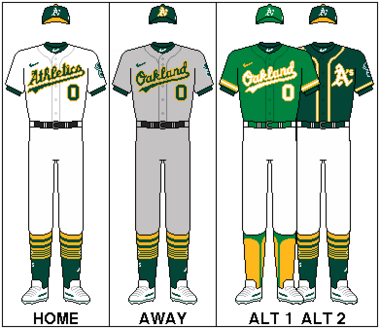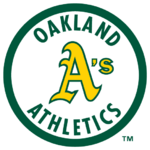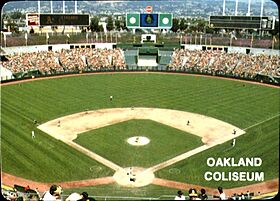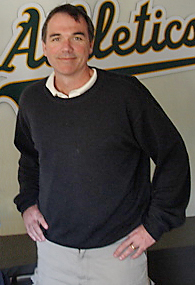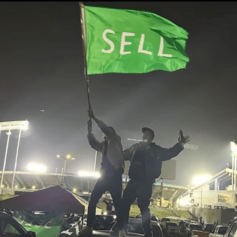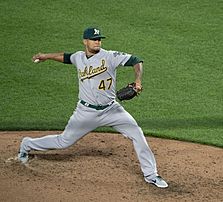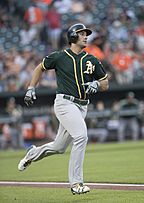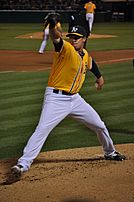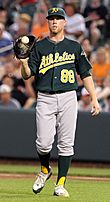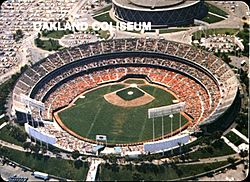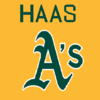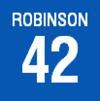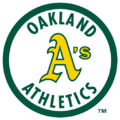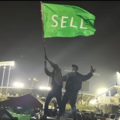Oakland Athletics facts for kids
Quick facts for kids Oakland Athletics |
|||||
|---|---|---|---|---|---|
|
|||||
| Information | |||||
| League | American League (1968–2024) West Division (1969–2024) |
||||
| Ballpark | Oakland Coliseum (1968–2024) | ||||
| Year established | 1968 | ||||
| Nickname(s) | The A's
|
||||
| American League pennants | 6
|
||||
| West Division titles | 17
|
||||
| World Series championships | 4
|
||||
| Wild Card championships | 4
|
||||
| Colors | Green, gold, white |
||||
| Mascot | Stomper Trunk Harry Elephante Charlie-O |
||||
| Retired numbers | |||||
| Ownership |
List of owners
Charlie Finley (1968–1980)
Walter A. Haas Jr. (1981–1995) Ken Hofmann (1995–2005) Stephen Schott (1995–2005) Lewis Wolff (2005–2016) John Fisher (2005–2024) |
||||
| Manager |
List of managers
Bob Kennedy (1968)
Hank Bauer (1969) John McNamara (1969–1970) Dick Williams (1971–1973) Alvin Dark (1974–1975) Chuck Tanner (1976) Jack McKeon (1977) Bobby Winkles (1977–1978) Jack McKeon (1978) Jim Marshall (1979) Steve Boros (1983–1984) Billy Martin (1980–1982) Jackie Moore (1984–1986) Jeff Newman (1986) Tony La Russa (1986–1995) Art Howe (1996–2002) Ken Macha (2003–2006) Bob Geren (2007–2011) Bob Melvin (2011–2021) Mark Kotsay (2022–2024) |
||||
| President |
List of presidents
Roy Eisenhardt (1981–1986)
Walter J. Haas (1990–1992) Sandy Alderson (1993–1995, 1997–1998) Michael Crowley (1998–2016) Dave Kaval (2016–2024) |
||||
| Uniforms | |||||
|
|||||
The Oakland Athletics, often called the Oakland A's, were a professional baseball team. They played in Major League Baseball (MLB) and were based in Oakland, California. The team was part of the American League (AL) West Division. They played their home games at the Oakland Coliseum from 1968 to 2024.
The Athletics won nine World Series championships. They also earned fifteen AL pennants and seventeen division titles. This made them the second most successful team in the AL after the New York Yankees. The team moved to Oakland in 1968 from Kansas City. Before that, they were in Philadelphia.
Despite their success, the Athletics left Oakland after the 2024 season. They moved to West Sacramento as the Athletics. They plan to move permanently to Las Vegas, Nevada in 2028. This move ended major league sports in Oakland. During their 56 years in Oakland, the Athletics had a winning record of 4,614 wins and 4,387 losses. Many former Oakland A's players are now in the National Baseball Hall of Fame.
Contents
- Team History in Oakland
- Moving to Oakland
- Early Years and Building a Strong Team (1968–1970)
- The "Swingin' A's" Dynasty (1971–1975)
- Changes and Challenges (1976–1980)
- The Haas Era: A New Beginning (1981–1995)
- The "Moneyball" Years (1996–2004)
- The Wolff Era (2005–2016)
- The Final Years in Oakland (2016–2024)
- Relocation to Sacramento and Las Vegas
- Team Uniforms
- Home Stadium History
- Team Rivalries
- Team Achievements
- Radio and Television Coverage
- Images for kids
Team History in Oakland
Moving to Oakland
The Athletics team moved from Philadelphia to Kansas City, Missouri in 1954. In 1960, Charlie Finley bought the team. He soon started looking for a new city for the Athletics. He considered places like Dallas, Louisville, and Seattle.
In 1964, Finley tried to move the team to Louisville. The other American League owners said no. They also denied his request to move the team to Oakland. But in October 1967, Finley announced Oakland as the team's new home. A week later, AL owners approved the move for the 1968 season.
Early Years and Building a Strong Team (1968–1970)
The Oakland Athletics played their first game in Oakland on April 17, 1968. They shared the Oakland–Alameda County Coliseum with the Oakland Raiders football team. On May 8, 1968, pitcher Catfish Hunter threw a perfect game. This was a rare achievement where no opposing player reached base.
The team improved quickly. In 1968, they had their first winning record since 1952. By 1969, led by Reggie Jackson's 47 home runs, they finished second in their division. The team kept getting better, setting the stage for future success.
The "Swingin' A's" Dynasty (1971–1975)
The Athletics became a powerhouse in 1971, winning 101 games. They won their division but lost in the playoffs. In 1972, they won their first league championship since 1931. They then faced the Cincinnati Reds in the World Series.
The A's started wearing bright green and gold uniforms. They also grew mustaches, which was unusual for baseball players then. This led to their nickname, "The Hairs vs. the Big Squares." The A's won the 1972 World Series, their first championship since 1930.
They continued their winning streak, defending their title in 1973 and 1974. This team was known as the "Swingin' A's." Key players included Reggie Jackson, Sal Bando, Joe Rudi, Bert Campaneris, Catfish Hunter, Rollie Fingers, and Vida Blue. These players often said they played well together despite disagreements with owner Charlie Finley.
After winning the 1974 World Series, pitcher Catfish Hunter became a free agent. He left the team and signed with the Yankees. Even without Hunter, the A's won their division again in 1975. However, they lost in the ALCS playoffs.
Changes and Challenges (1976–1980)
In 1976, new rules allowed players to become free agents more easily. Owner Charlie Finley tried to sell some star players. However, the baseball commissioner stopped these sales. After the 1976 season, many veteran players left the team as free agents.
The team struggled greatly from 1977 to 1979. They finished last or near last in their league. Attendance at games dropped very low. The stadium was sometimes called the "Oakland Mausoleum" because so few fans showed up. In 1979, one game had only 653 fans.
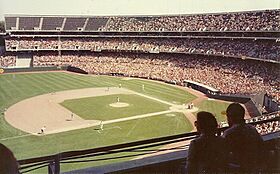
The A's also had trouble getting radio and TV deals. This made it hard for fans to follow the team. Finley tried to sell the team to owners who wanted to move them to Denver or New Orleans. But Oakland officials prevented the move.
In 1980, Finley hired Billy Martin as manager. Martin led a young team with new stars like Rickey Henderson. The team improved, finishing second in their division. Finley then sold the team to Walter A. Haas, Jr., the president of Levi Strauss & Co.
The Haas Era: A New Beginning (1981–1995)
Under Walter Haas's ownership, the A's became very popular. Attendance soared, showing that fans wanted to support the team. Haas changed the team's image, bringing back the traditional "Athletics" name. He also restored the elephant mascot in 1988.
The team's minor league system was rebuilt. This brought up talented young players like José Canseco, Mark McGwire, and Walt Weiss. In 1986, Tony La Russa became the manager. Under his leadership, the A's won the American League championship three years in a row (1988–1990).
This successful team included stars like McGwire, Canseco, Rickey Henderson, and Dave Stewart. Rickey Henderson set a new record by stealing 130 bases in 1982. In 1991, he broke the all-time stolen base record.
The A's won the 1989 World Series by sweeping their cross-bay rivals, the San Francisco Giants. This series was famous for being interrupted by the Loma Prieta earthquake. The A's also reached the World Series in 1988 and 1990 but lost both times. The team started to decline after 1992.
The "Moneyball" Years (1996–2004)
After Walter Haas passed away in 1995, the team was sold to new owners. They focused on cutting player salaries. Many star players were traded away. Despite this, the A's often finished at the top of their division.
From 2000 to 2003, the Athletics made the playoffs four years in a row. However, they lost in the first round each time. In 2001 and 2003, they even won the first two games but then lost the next three.
This period featured a strong group of young pitchers: Tim Hudson, Mark Mulder, and Barry Zito. They were known as the "Big Three." Along with talented hitters like Jason Giambi and Miguel Tejada, they made the A's a strong team.
The team's general manager, Billy Beane, became famous for his unique approach to building a team. This strategy was called "Moneyball." Instead of focusing on traditional baseball skills, Beane looked for players with undervalued statistics. This allowed the A's to compete with teams that had much higher payrolls. For example, in 2002, the A's won 103 games with a low payroll.
In 2002, the Athletics also set an American League record by winning 20 games in a row. This amazing streak included dramatic comeback wins. The 20th win was especially memorable, as the A's came back from an 11-run deficit to win in the final inning.
The Wolff Era (2005–2016)
In 2005, the Athletics were sold to a group led by Lewis Wolff. Many experts thought the A's would struggle that year. However, the team played very well in the second half of the season. They finished strong, showing their resilience.
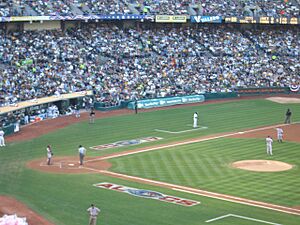
In 2006, the A's returned to the playoffs. They swept the Minnesota Twins in the first round. But they were then swept by the Detroit Tigers in the next round. After the season, manager Ken Macha was replaced by Bob Geren.
The 2007 season was tough due to many player injuries. The A's had a losing record for the first time in years. In 2008, the team traded away several key players, which upset many fans. Despite this, the A's played surprisingly well early in the season.
On May 9, 2010, A's pitcher Dallas Braden threw a perfect game. This was a rare event, only the 19th in Major League history. The A's finished the 2010 season with an even record of 81 wins and 81 losses.
In 2012, despite trading away several star pitchers, the A's surprised everyone. They won their division on the very last day of the season. They led the league in "walk-off" wins, where they won in their final turn at bat. Manager Bob Melvin won the AL Manager of the Year award. The A's lost in the playoffs to the Detroit Tigers.
In 2013, the A's won their division again. They had another great season but again lost to the Detroit Tigers in the playoffs. In 2014, the A's started strong and were a favorite to win their division. They made some big trades to get more star pitchers. However, they struggled later in the season. They made the playoffs as a Wild Card team but lost a dramatic game to the Kansas City Royals.
The 2015 season was disappointing, with the A's finishing last in their division. They began to rebuild their team, bringing in new young players.
The Final Years in Oakland (2016–2024)
In 2016, the A's finished last again. However, new players like Khris Davis had strong seasons. In November 2016, John J. Fisher became the full owner of the team.
The A's finished last for a third straight year in 2017. They traded away ace pitcher Sonny Gray but brought in future stars like Matt Chapman.
In 2018, the A's surprised everyone by winning 97 games. They earned a spot in the playoffs as a wild card team. Manager Bob Melvin won his third AL Manager of the Year award. On April 21, Sean Manaea threw a no-hitter for the A's.
In 2019, Mike Fiers threw another no-hitter for the A's. For the second year in a row, the A's won 97 games and made the playoffs. They hosted the Wild Card game but lost to the Tampa Bay Rays.
The 2020 season was shorter due to the COVID-19 pandemic. The A's won their division and beat the Chicago White Sox in the first round of the playoffs. They then lost to the Houston Astros.
In 2021, the A's finished third in their division and missed the playoffs. After the season, manager Bob Melvin left the team. Major League Baseball also gave the A's permission to look for a new city, saying the Oakland Coliseum was not suitable for the future.
Before the 2022 season, the A's traded away many key players. This led to a very tough season, with the team finishing last in their division. It was their worst record since 1979.
Relocation to Sacramento and Las Vegas
In April 2023, the Athletics announced plans to move to Las Vegas. They bought land for a new stadium. By June 2023, the Nevada Legislature approved funding for the new ballpark. The team officially applied to move in August. The A's finished the 2023 season with the worst record in Major League Baseball.
On November 16, 2023, MLB officially approved the move to Las Vegas. In April 2024, the team announced that 2024 would be their last season in Oakland. They would play in West Sacramento for three seasons until their Las Vegas stadium is ready. The Athletics played their final game in Oakland on September 26, 2024, winning 3–2. Their last game as an Oakland-based team was on September 29, 2024, losing on the road.
Fan Reaction to the Move
Many fans in the Bay Area were very upset about the A's moving to Las Vegas. Baseball writers and former players also expressed disappointment. Many believed the team's owner did not spend enough money on the team. They thought this was a way to make fans stay away and help the team move.
Fans protested the move at games in Oakland and other cities. The "Sell" movement continued into the 2024 season. Some fans also started supporting the Oakland Ballers, a new local baseball team.
Team Uniforms
When the A's moved to Oakland, owner Charlie Finley used bright "Kelly Green, Wedding Gown White and Fort Knox Gold" colors. He experimented with bold uniforms, including gold tops and green undershirts. In the 1970s, the "Swingin' A's" wore many different uniform combinations. They never wore traditional gray on the road, always green or gold.
After the team was sold to the Haas family in 1981, the main color changed to a darker forest green. The team started using more traditional uniforms. The elephant mascot was brought back, and the "Athletics" script returned to the jerseys.
The team's home uniforms had "Athletics" written in script. Road uniforms said "Oakland" in script. The cap had a traditional "A's" logo. The home cap was forest green with a gold bill. The road cap was all forest green.
From 1994 to 2013, the A's wore green alternate jerseys. In the 2000s, they briefly added black as a team color. They wore black alternate jerseys, but these were later retired. A gold alternate jersey was introduced in 2011.
In 2018, for their 50th anniversary in Oakland, the A's wore a special kelly green uniform. This uniform became their main alternate uniform. The nickname "A's" has been used for a long time. It was officially the team name from 1972 to 1980. New owner Walter Haas brought back "Athletics" as the official name in 1981.
Home Stadium History
The Oakland Coliseum was built as a multi-purpose stadium. It hosted both baseball and football games. In 1995, the Oakland Raiders football team moved back to Oakland. The Coliseum was expanded, and a large grandstand called "Mount Davis" was added in the outfield. This changed the stadium's look.
The added seats in Mount Davis were often empty. This made the stadium feel less full, even with many fans. In 2005, the A's stopped selling tickets for the upper deck and Mount Davis. This reduced the stadium's capacity, making it the smallest in MLB. The A's were the last MLB team to share a stadium with an NFL team. This ended when the Raiders moved to Las Vegas in 2020.
The Oakland Athletics' spring training facility was Hohokam Stadium in Mesa, Arizona.
Coliseum Improvements
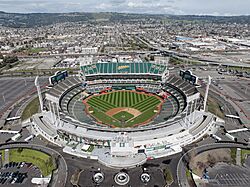
In 2017, the team added an outdoor plaza with food trucks and games. The next year, they opened "The Treehouse," a large area with bars and seating for all fans. They also created "The A's Stomping Ground," a fun area for kids with games and a miniature baseball field.
New premium seating options were added in 2019. The team also removed the tarps from the upper deck, increasing capacity. The playing field was renamed "Rickey Henderson Field." On April 17, 2018, the A's held a free game to celebrate their 50th anniversary in Oakland. A record crowd of 56,310 fans attended a game in 2018.
Past Stadium Plans
The Oakland A's had been trying to build a new baseball-only stadium since the early 2000s. They wanted to stay in Oakland. One plan in 2017 was for a new stadium near Laney College. However, negotiations ended quickly. In 2018, the A's announced plans for a new stadium at the Howard Terminal site at the Port of Oakland. They also wanted to redevelop the Coliseum site. In April 2023, the city of Oakland ended talks with the A's.
The A's also explored moving to Fremont in 2006. The plan was for a stadium called Cisco Field. But this plan faced delays and opposition from the community.
In 2009, San Jose tried to get the team to move there. However, the San Francisco Giants claimed territorial rights to that area. This made a move to San Jose very difficult. The city of San Jose even sued MLB to allow the move, but the lawsuit was rejected by the Supreme Court in 2015.
Team Rivalries
San Francisco Giants
The "Bay Bridge Series" was the name for games played between the Oakland A's and the San Francisco Giants. The name came from the San Francisco–Oakland Bay Bridge that connects the two cities. This rivalry was usually friendly. Fans often wore hats with both teams' logos. Locals called it the "Battle of the Bay."
The teams first met in the 1989 World Series, which the A's won. Since 1997, they also played each other during the regular season. The A's had a slightly better record in these regular season games. The A's also had more playoff appearances, division titles, and World Series wins than the Giants since both teams moved to the Bay Area.
In 2018, the teams started battling for a "Bay Bridge" Trophy. It was made from steel from the old Bay Bridge. The A's won the first trophy. When the A's left Oakland, the Giants had won the trophy 4 times, and the A's had won 3.
Los Angeles Angels
The A's also had a rivalry with the Los Angeles Angels. This rivalry started when both teams became part of the AL West division in 1969. The two teams often competed for the division title. The rivalry was strongest in the early 2000s.
In 2002, the A's won a league-record 20 games in a row. They finished ahead of the Angels in the division. However, the A's lost in the playoffs, while the Angels went on to win the World Series. In 2004, the two teams battled for the division title until the very last week of the season. The Angels won the division by beating the A's in a key series. The A's had a winning record against the Angels during their time in Oakland.
Team Achievements
Awards and Hall of Famers
The Oakland Athletics gave out the Catfish Hunter Award each year. It honored the most inspiring player on the team.
Many players who played for the Athletics are in the National Baseball Hall of Fame. These include Dennis Eckersley, Rollie Fingers, Rickey Henderson, and Dick Williams.
| Oakland Athletics Hall of Famers | |||||||||
|---|---|---|---|---|---|---|---|---|---|
| Affiliation according to the National Baseball Hall of Fame and Museum | |||||||||
|
Retired Numbers
The Oakland Athletics retired six jersey numbers. They also honored former owner Walter A. Haas, Jr. by retiring the letter "A". Five of the retired numbers belonged to players who played most of their careers in Oakland. Number 42 was retired across all of Major League Baseball to honor Jackie Robinson.
Dave Stewart's number 34 was retired on September 11, 2022. This was special because his number was re-retired, and he is not in the Hall of Fame.
|
Oakland Athletics Hall of Fame
On August 14, 2018, the team started its own Hall of Fame. Seven people were inducted in the first group. Each person was honored with a painting and a green jacket. The Hall of Fame continued to induct new members in 2019, 2022, 2023, and 2024.
| Bold | Member of the Baseball Hall of Fame |
|---|---|
|
|
Member of the Baseball Hall of Fame as an Athletic |
| Bold | Recipient of the Hall of Fame's Ford C. Frick Award |
| Oakland Athletics Hall of Fame | ||||
| Year | No. | Player | Position | Tenure |
|---|---|---|---|---|
| 2018 | 43 | Dennis Eckersley |
P | 1987–1995 |
| 32, 38, 34 | Rollie Fingers |
P | 1968–1976 | |
| 39, 35, 22, 24 | Rickey Henderson |
LF | 1979–1984 1989–1993 1994–1995 1998 |
|
| 27 | Catfish Hunter | P | 1968–1974 | |
| 9, 44 | Reggie Jackson | RF | 1968–1975 1987 |
|
| 34, 35 | Dave Stewart | P | 1986–1992 1995 |
|
| — | Charlie Finley | Owner General Manager |
1968–1981 | |
| 2019 | 10, 11, 22, 42 | Tony La Russa | IF Manager |
1968–1971 1986–1995 |
| 14, 17, 21, 28, 35 | Vida Blue | P | 1969–1977 | |
| 19 | Bert "Campy" Campaneris | SS | 1968–1976 | |
| 25 | Mark McGwire | 1B | 1986–1997 | |
| — | Walter A. Haas, Jr. | Owner | 1981–1995 | |
| 2022 | 30, 3 | Eric Chavez | 3B | 1998–2010 |
| 6 | Sal Bando | 3B | 1968–1976 | |
| 45, 8, 36, 26 | Joe Rudi | LF / 1B | 1968–1976 1982 |
|
| 10 | Ray Fosse | C Broadcaster |
1973–1975 1986–2021 |
|
| — | Keith Lieppman | Director of Player Development | 1971–present | |
| — | Steve Vucinich | Clubhouse manager | 1968–present | |
| 2023 | 16 | Jason Giambi | LF / 1B | 1995–2001 2009 |
| 5, 4 | Carney Lansford | 3B | 1983–1992 | |
| 24, 38, 18 | Gene Tenace | C / 1B | 1969–1976 | |
| — | Roy Steele | Public address announcer | 1968–2005 2007–2008 |
|
| 2024 | 33 | Jose Canseco | RF / DH | 1985–1992 1997 |
| 36 | Terry Steinbach | C | 1986–1996 | |
| 4 | Miguel Tejada | SS | 1997–2003 | |
| 23 | Dick Williams |
Manager | 1971–1973 | |
| — | Bill King | Broadcaster | 1981–2005 | |
Bay Area Sports Hall of Fame

17 people from the Athletics organization are in the Bay Area Sports Hall of Fame.
| Athletics in the Bay Area Sports Hall of Fame | ||||
| No. | Player | Position | Tenure | Notes |
|---|---|---|---|---|
| 12 | Dusty Baker | OF | 1985–1986 | |
| 14, 17, 21, 28, 35 | Vida Blue | P | 1969–1977 | |
| 19 | Bert "Campy" Campaneris | SS | 1964–1976 | |
| 12 | Orlando Cepeda | 1B | 1972 | Elected mainly on his performance with San Francisco Giants |
| 4, 6, 10, 14 | Sam Chapman | CF | 1938–1941 1945–1951 |
Born and raised in Tiburon, California |
| 43 | Dennis Eckersley | P | 1987–1995 | Grew up in Fremont, California |
| 32, 34, 38 | Rollie Fingers | P | 1968–1976 | |
| — | Walter A. Haas, Jr. | Owner | 1981–1995 | Grew up in San Francisco, California, attended UC Berkeley |
| 24 | Rickey Henderson | LF | 1979–1984 1989–1993 1994–1995 1998 |
Raised in Oakland, California |
| 27 | Catfish Hunter | P | 1965–1974 | |
| 9, 31, 44 | Reggie Jackson | RF | 1968–1975 1987 |
|
| 1 | Eddie Joost | SS Manager |
1947–1954 1954 |
Born and raised in San Francisco, California |
| 10, 11, 22, 29, 42 | Tony La Russa | IF Manager |
1963 1968–1971 1986–1995 |
|
| 1, 4 | Billy Martin | 2B Manager |
1957 1980–1982 |
Elected mainly on his performance with New York Yankees, Born in Berkeley, California |
| 44 | Willie McCovey | 1B | 1976 | Elected mainly on his performance with San Francisco Giants |
| 8 | Joe Morgan | 2B | 1984 | Elected mainly on his performance with Cincinnati Reds, raised in Oakland, California |
| 19 | Dave Righetti | P | 1994 | Born and raised in San Jose, California |
| 34 | Dave Stewart | P | 1986–1992 1995 |
Born and raised in Oakland, California |
Radio and Television Coverage
As of the 2020 season, the Oakland Athletics had 14 radio stations broadcasting their games. Their main radio station was KNEW. They also had a free 24/7 online station called A's Cast for fans in the Oakland area. The announcers for the radio broadcasts were Ken Korach and Vince Cotroneo.
Television coverage was mainly on NBC Sports California. Some games were shown on NBCS Plus if another sports event was on the main channel. On TV, Jenny Cavnar did the play-by-play, and Dallas Braden provided commentary. Sometimes, Chris Caray also did play-by-play.
Images for kids
-
The Oakland Athletics playing host to the Texas Rangers at the Oakland–Alameda County Coliseum during a 1981 home game.
-
Game 1 of the 2006 ALCS in Oakland, California
-
Former alternate forest green uniform (2014–2021), worn by Matt Olson
-
Oakland Coliseum, which was the 5th oldest MLB stadium by the time of the A's last game.
-
Dave Stewart, Oakland Athletics pitcher from 1986 to 1992 and 1995




